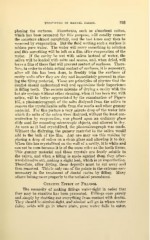Page 331 - My FlipBook
P. 331
TREATMENT OF DENTAL CARIES. 193
planing the surfaces. Absorbents, such as absorbent cotton,
which has been prepared for this purpose, will readily remove
the moisture almost completely, and the last trace may then be
removed by evaporation. But the fluid wetting such a surface is
seldom pure water. The water will carry something in solution
and this something will be left as a film after evaporation of the
water. If the cavity be wet with saliva instead of water, the
saliva will be loaded with salts and mucus, and, when dried, will
leave a film of these that will prevent contact of surfaces. There-
fore, in order to obtain actual contact of surfaces, it is necessary,
after all this has been done, to freshly trim the surfaces of
cavity walls after they are dry and immediately proceed in plac-
ing the filling material. These are principles of physics that the
dentist should understand well and appreciate their importance
in filling teeth. The serious mistake of drying a cavity with the
hot air syringe without other cleaning, when it has been wet with
saliva, will be better appreciated by the examination of Figure
167, a photomicrograph of the salts dialyzed from the saliva to
remove the crystallizable salts from the mucin and other gummy
material. For this picture a very minute drop of the water into
which the salts of the saliva were dialyzed, without the least con-
centration by evaporation, was placed upon an ordinary glass
slide used for mounting microscopic objects, and allowed to dry.
As soon as it had crystallized, the photomicrograph was made.
Without the dialyzing, the gummy material in the saliva would
add to the bulk of the film. Any one may see this residue by
placing a drop of saliva on a clean glass and allowing it to dry.
When this has crystallized on the wall of a cavity, it is white and
can not be seen because it is of the same color as the tooth tissue.
This gummy material and these crystals are freely soluble in
the saliva, and when a filling is made against them they after-
ward dissolve out, making a slight leak, which is an imperfection.
Therefore, after drying, these deposits must be cut away and
then removed. This is only one of the points in the extreme care
necessary in the treatment of dental caries by filling. Many
others belong more properly to the technical procedures.
Curative Effect of Fillings.
The necessity of making fillings water-tight in order that
they may be curative has been presented. Fillings cure purely
and simply by shutting out everything from contact with dentin.
They should be alcohol-tight, and alcohol will go in where water
fails; acids will go in where plain, pure water fails to enter.


